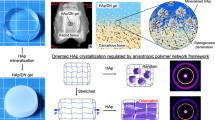Abstract
Hydrogel is a kind of three-dimensional network polymer formed by chemical bond or physical cross-linking. It is widely used in the field of biomaterial because of its good biocompatibility. In this experiment, a gel-based composite material for 3D bioprinting was prepared using hyaluronic acid-methyl cellulose (HAMC) gel as carrier and nano-hydroxyapatite/collagen (nHAC). The effects of gel formulation on gel process were analyzed by in vitro gel test, rheological analysis, in vitro degradation and scanning electron microscopy. The results showed that HAMC with different mineralized collagen concentration could be rapidly gelatinized at 37 °C within 3 min. The rheological experiments showed that the HAMC-mineralized collagen had shear thinning properties suitable for 3D bioprinting. The results showed that the degradation rate was similar in the first 10 days, but the degradation rate was slower with the increase of mineralized collagen concentration. The porous structure and high porosity of the hydrogel were observed by scanning electron microscopy (SEM). The porous structure of the cross-linked sample was better.
Access this chapter
Tax calculation will be finalised at checkout
Purchases are for personal use only
Similar content being viewed by others
References
Jagur-Grodzinski J (2010) Polymeric gels and hydrogels for biomedical and pharmaceutical applications. Polym Adv Technol 21(1):27–47
Kopecek J (2007) Hydrogel biomaterials: a smart future? Biomaterials 28(34):5185–5192
Sun JY, Zhao X, Illeperuma WRK (2012) Highly stretchable and tough hydrogels. Nature 489(7414):133–136
Roy I (2003) Gupta M N. Smart polymeric materials: emerging biochemical applications. Chem Biol 10(12):1161–1171
Calvert P (2009) Hydrogels for soft machines. Adv Mater 21(7):743–756
Malda J, Visser J, Melchels FP et al (2013) 25th anniversary article: engineering hydrogels for biofabrication. Adv Mater 25(36):5011–5028
Song Q, Hu K, Cui FZ et al (2009) Effect of high temperature on morphology and structure of nano-hydroxyapatite/collagen composite. Mater Sci Forum 1360–1363 (2009)
Cui F, Feng Q (2004) Biomaterials science, 2nd edn. Tsinghua University Publication, China
Zhou H, Lee J (2011) Nanoscale hydroxyapatite particles for bone tissue engineering. Acta Biomater 7(7):2769–2781
Wu X, Liu S, Yeung KWK, Liu C, Yang X (2014) Biomimetic porous scaffolds for bone tissue engineering. Mater Sci Eng R Rep 80(1):1–36
Hench LL, Polak JM (2002) Third-generation biomedical materials. Science 295(5557):1014–1016
Takeda A, Tamano H (2016) Significance of low nanomolar concentration of Zn(2+) in artificial cerebrospinal fluid. MolNeurobiol 1–6 (2016)
Acknowledgements
This study is funded by University scientific research project-3D Printing mineralized collagen-based child mandible (Grant No. 20190116002/037), Students research-Medical X-ray imaging measurement tape prepared by screen printing (Grant No. 22150116005/074). High level crossing training plan of Beijing high school-Construction of small-caliber artificial blood vessels with cells.
Author information
Authors and Affiliations
Corresponding author
Editor information
Editors and Affiliations
Rights and permissions
Copyright information
© 2018 Springer Nature Singapore Pte Ltd.
About this paper
Cite this paper
Yan, J. et al. (2018). Preparation of Hydrogel Material for 3D Bioprinting. In: Zhao, P., Ouyang, Y., Xu, M., Yang, L., Ren, Y. (eds) Applied Sciences in Graphic Communication and Packaging. Lecture Notes in Electrical Engineering, vol 477. Springer, Singapore. https://doi.org/10.1007/978-981-10-7629-9_116
Download citation
DOI: https://doi.org/10.1007/978-981-10-7629-9_116
Published:
Publisher Name: Springer, Singapore
Print ISBN: 978-981-10-7628-2
Online ISBN: 978-981-10-7629-9
eBook Packages: EngineeringEngineering (R0)




